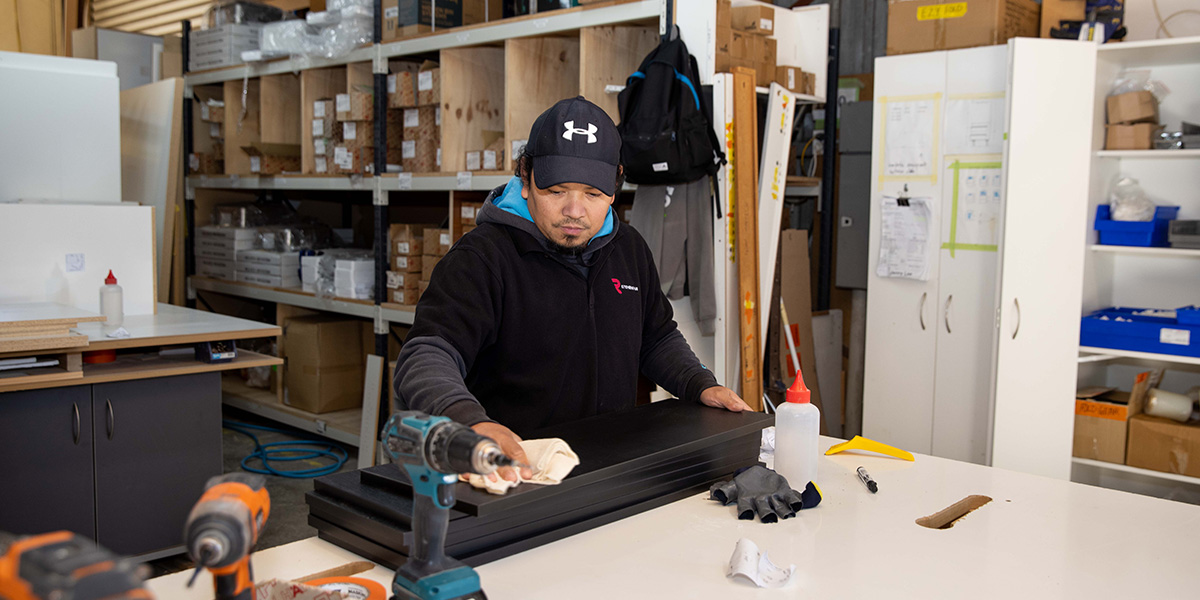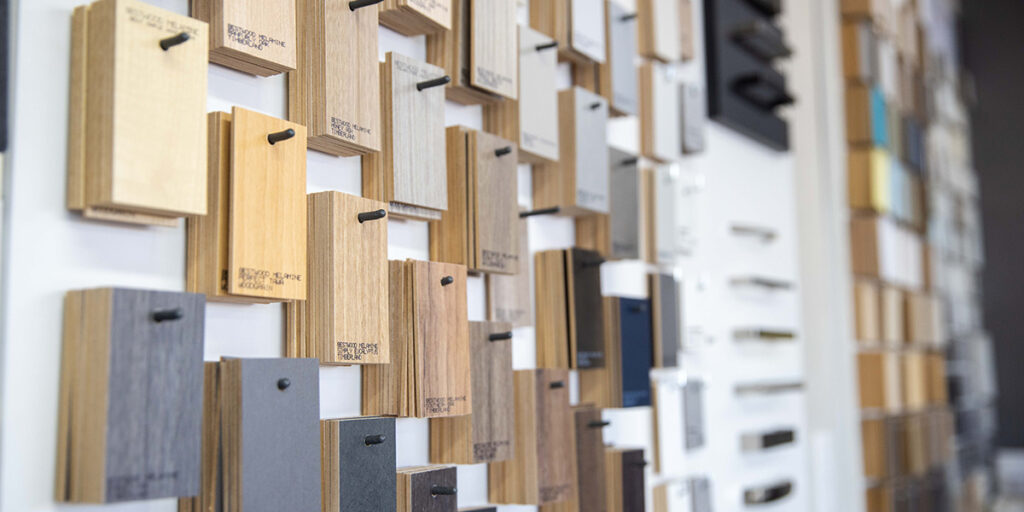Our Advice On The Kitchens Renovation Journey
Updating your kitchen is one of the biggest renovation investments you will make, so it’s important that you get it right! Just as you trust your builder or architect, you need to find a kitchen designer that you trust.
It takes many years to gather the experience and knowledge to be a good kitchen designer, so make sure you put your trust in someone who can demonstrate a wide and practical knowledge of kitchen design, fittings, and available materials.
Instead of relying on someone who promises the world and can draw a pretty picture, it’s crucial to work with a knowledgeable kitchen designer who can deliver the desired result within your budget. They will ensure that your kitchen is not only aesthetically pleasing but also a dream to work in and create lasting family memories.
Our kitchen designers share their advice, outlining the essential things to consider before starting your kitchen renovation, all for free. We share everything we know because we want your renovation to be a resounding success!
Consider Moving Away From the Traditional Kitchen Triangle Concept.
The kitchen triangle is an essential planning tool, but modern kitchens don’t necessarily need to be strictly confined to this format. The kitchen triangle is at the forefront of every designer’s mind. Having everything within reach means storing food and cooking as efficiently as possible.
Essentially, a good design is where all your appliances are in an area where they can be reached efficiently. The position of your appliances needs careful consideration, along with their size and specifications.
The dishwasher should open freely, not impede the walkways, and allow for easy unloading into your crockery, knife, and fork drawer, all while being in close proximity to your sink for rinsing and loading.
So, ask yourself the following questions about your appliances:
- Is the access good? Can I stand in front of my appliance without feeling squashed against anything?
- Will the doors open freely, even if someone is trying to get past them?
- Is a walkway impeded or blocked when I open my appliance?
- Is it safe to carry hot items from appliances, such as ovens or microwaves, to the sink bench if there are small children around?
- Can I reach my major appliances with only a few short steps?
The concept behind the kitchen work triangle is that primary tasks are carried out within a triangular space between the cooktop, sink, and refrigerator for efficiency.
However, stepping outside of the triangle and customising your layout to suit your needs is perfectly fine if it doesn’t compromise the functionality of the appliances and how you want to use your kitchen.
For example, entertainers may want a second dishwasher in their butler’s pantry, or larger families might like to introduce a second sink or an extra oven.
Perhaps having your fridge further away from your working triangle suits the way you want to use your kitchen space. The triangle is a great starting point, but you needn’t be confined to it if it doesn’t work for you.
Instead, think about how you wish to use the space, make a list of the functional things you would like your kitchen to do for you, and discuss how you want the kitchen to relate to other areas in the house with your kitchen designer to customize an efficient layout for your home.
Consider Your Benchtop Space
Appliances that take up a large portion of your kitchen will reduce your benchtop space.
Large sink(s), large appliances, large benchtop appliances.
The larger the sink(s), the less bench space you’ll have. Sometimes it’s better to compromise on the size of the sink to gain a few extra 100mm of benchtop if your space is tight.
A large oven or fridge freezer will quickly consume your kitchen if space is limited.
Large appliances need to be placed with enough clearance to ensure good access and functionality.
Benchtop appliances are best housed either below the bench or on the wall above.
Aim for clear bench space in your design.
Plan your appliances with your designer so you can weigh up the advantages and disadvantages before making your purchase.
Most kitchen companies can arrange commercial pricing for appliances, so there’s no advantage in buying hastily during a sale.
What will be your new benchtop surface?
Kitchen renovators are fortunate to now have a wide variety of benchtop options available when considering surfaces.
From timbers and stone to acrylics, laminates, and glass, your kitchen palette can be as organic, industrial, or warm as you desire.
Surfaces play a significant role in the visual design and functionality of your kitchen space. Gloss surfaces can reflect light and noise, while laminate surfaces can soften the ambience of your kitchen.
Engineered stone benchtops are the most common choice due to their endurance, availability, and pricing.
(If you’re renovating for resale, choose an engineered stone benchtop for maximum impact and value.)
Consider how the surfaces you’re interested in will work with the rest of your home.
If you plan on upgrading the bathrooms and laundry in the future, it’s a good idea to keep the surfaces uniform or at least within the same palette throughout your home. Consider compromising on a benchtop that fits your budget and can be used throughout the home for a sleek and elegant look.

Benchtop Surfaces
Kitchen renovators are fortunate to now have a wide variety of benchtop options available to them when considering surfaces.
From timbers and stone to acrylics, laminates, and glass, your kitchen palette can be as organic, industrial, or warm as you desire.
Surfaces play a significant role in the visual design and functionality of your kitchen space. Gloss surfaces can reflect light and noise, while laminate surfaces can soften your kitchen space.
Engineered stone benchtops are by far the most common choice due to their durability, availability, and pricing. (If you’re renovating for resale, choose an engineered stone benchtop for maximum impact and value.)
How do the surfaces you’re interested in work with the rest of your home? If you intend to upgrade the bathrooms and laundry in the future, it’s a good idea to keep the surfaces uniform or at least within the same palette throughout your home. Consider compromising on a benchtop that fits your budget and can be used throughout the home for a very sleek and elegant look.
Kitchen Lighting
Lighting design is an important component of a kitchen renovation, but many homeowners don’t get this right. Avoid hotspots and shadows in your lighting plan by carefully considering the placement of your lighting.
Ambient lighting will provide overall illumination for your kitchen, radiating a comfortable level of brightness.
Task lighting will help you perform specific tasks such as food preparation and is often used in kitchen and laundry workspaces.
Accent lighting can be used to create visual interest in your room. Perhaps you wish to draw the eye to your splashback, artwork, or the height of your kitchen ceiling.
It’s best to match the strip lighting colour with that of your range hood. If your rangehood is new, check the colour of the lighting and match it with your downlights or strip lighting.
Consider how you will use lighting in your space and consult with a professional to ensure your lighting plan is right for the size and height of your area.
Flooring Options
Believe it or not, flooring is often an afterthought for many kitchen renovators. Flooring can have a big impact on your kitchen renovation budget so start thinking about this at the planning stage to avoid a budget blowout.
Flooring is something that must be decided on very early on in the kitchen design phase as certain flooring choices affect the way the kitchen is designed & installed and can make the installation process take longer with multiple visits juggling tradespeople. Talk to your Design team about what flooring you thinking of having early on, so it can be factored into the design.
What To Do With Your Old Kitchen
If your existing kitchen is on tiles or a dated floor, you will need to look at updating the flooring as part of your kitchen renovation. Again, the look of the kitchen must be consistent with the remainder of your home so that could indeed mean re-flooring more than one area in your home.
There is a range of flooring options available to homeowners these days so be sure to look at an option that can withstand the test of time and the foot traffic your kitchen will inevitably attract.
Consider Your Budget
The biggest mistake people make when planning their kitchen is not being realistic about their budget.
- Kitchen cabinetry & Benchtops
- Flooring
- Appliances
- Builders
- Electrical
- Plumbing
Depending on the size of your renovation, you should aim to spend between 5-10% of your property value and this should cover any unexpected contingency for events such as trade delays or issues with flooring or walls behind the old kitchen that may need repairs, prior to kitchen and flooring installation.
Remember that your trades, appliances, flooring, lighting, cabinets, and fittings all need to work within your budget so plan ahead or speak with a professional kitchen designer to work out an estimate for each, so you can better plan & be confident that there won’t be a budget blow out.
Minimise Disruption
Again your kitchen team can help minimize the mess and inconvenience of multiple trades underfoot.
Plan for how the week of the installation will impact your family and start working on a contingency.
Think about rubbish removal, covering flooring and furniture, and how you will prepare meals and lunches, and wash up while your space is out of action. If you have a plan, your home won’t be thrown into disarray come build week and that means less stress for all involved.
Ideally, your Kitchen team will manage your project to minimize the inconveniences.
Find a Trusted Designer
The most successful renovations are where the Customer & Designer have a connection, built around trust.
You must pick a kitchen team that you can be frank with & trust. Then your job is to work alongside them.
A good kitchen Designer will guide you through all the choices & decisions and take the worry out of the equation and make sure you get the best value for your spend. They will have the knowledge, manufacturing team, and contacts to take care of all the steps to ensure a smooth transition from the old to the new!




